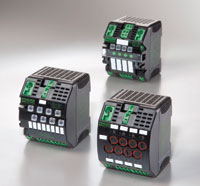
Posted to News on 23rd Nov 2016, 00:00
Give breakers a break
The experts at Murrelektronik offer advice on how to better protect your 24V DC control circuits.

Do any of these 24V DC control circuit problems sound familiar? Sensor and actuator cables get very hot, melt or catch fire without the breaker reacting; you have to shut down the machine to reset a breaker, repair sensor cables or replace a fuse; you have to open the control cabinet to see which breaker or fuse failed, and keep the cabinet open to troubleshoot a circuit; The power supply shuts down during a short circuit or overload; you’ve had to oversize your oversize our power supply to prevent it drawing down before the breakers trip; you’ve had to oversize your breaker or fuse to avoid them blowing during machine start-up; and you have to keep many different breakers and fuses in stock.
If you experience any of these problems, you are feeling the pain of using traditional circuit breakers and fuses to protect 24V DC control circuits. When you look in a typical control cabinet, you spot glass fuses, cartridge fuses or circuit breakers. These devices have been wired and sized the same way since they first became commercially available in the 1930s. Over the years, control engineers have learned to live with the way these devices operate, including their slow reaction time and limited sensitivity. And it can be time-consuming and costly for personnel to have to open a control cabinet – or, even worse, shut down a whole production line – while technicians strive to troubleshoot a circuit.
Sometimes you can’t afford to live with these limitations, and you replace an installed breaker or fuse with a higher-current version to prevent nuisance tripping. Or perhaps you replace a power supply with a larger model with a higher protection point so you won’t lose an entire control circuit if the breaker fails to react. And sometimes you worry about whether your cables and devices are properly protected.
Today, control engineers have an alternative form of circuit protection and monitoring device based on solid-state electronics. ‘Electronic fuses’ have proven themselves in the field for more than 10 years, in many applications, delivering faster reaction time, more precise operation, lower power consumption, less electrical ‘noise’ on the output, smaller size and lighter weight, reduced sensitivity to mechanical shock, vibrations, humidity or magnetic fields, and longer life expectancy.
These new electronic circuit-protection devices can do things that traditional breakers and fuses were never designed to do. For example, standard breakers and fuses cannot monitor and analyse circuits. Modern solid-state devices are designed to analyse any fault, or possible fault, conditions and react quickly. When these new devices sense an overload, they can isolate that circuit to prevent any damage, then monitor it to see if the overload subsides. This enables these devices to accommodate a machine start-up without any nuisance tripping. Some can even be programmed for a cascading start, with a certain time delay for each branch that eliminates start-up peaks.
Some of the newer solid-state devices can monitor a circuit, and send a relay contact signal to another device like a stack light, HMI or PLC to alert an operator of a fault. LEDs on the monitoring device (or other contacts) can show the affected circuit, and help a technician trace the problem and fix the cable. Once the repair is complete, a quick and easy remote reset can be done to clear the fault – without ever needing to open the control cabinet. This saves a tremendous amount of time and labour.
Compared to a traditional thermal breaker, a solid-state device offers massive improvements in reaction times, reacting hundreds or even thousands of times faster because it uses a precise set point as a reference, and reacts as soon as the current goes beyond that set point. In some instances, that could be cutting almost a minute of over-current stress from sensitive loads, and preventing costly damage and time consuming equipment repair or breaker resetting.
Indeed, these newer devices can pay for themselves in a single incident. Electronic circuit protection can eliminate the wait for a technician to open control cabinets. They shorten troubleshooting time by showing an LED or an alert to the exact circuit in question. Since they react much faster to faults, they spare cables and components from over-current stress and heat, and reduce the risk of fire. They provide for remote reset, saving many more steps. Best of all, they help avoid any costly shutdown of production equipment during troubleshooting, reset or restart.
Electronic circuit-protection is still new to some engineers, but there is no learning curve. You can size these electronic devices exactly the same as a traditional breaker, and many engineers find the newer devices make installation faster and easier, as they install just like a breaker but with less wiring. Some of the newer devices provide current-selection switches for each branch, which makes any future adjustments quick and easy.
Murrelektronik has been pioneering this new approach to circuit protection for many years, with the company’s MICO family of electronic circuit-protection devices, for example, featuring current selection, overload monitoring, remote reset, fault notification, remote on/off for energy savings, and more. Other benefits include a streamlining of inventory: while fuses may blow, solid-state devices don’t, so they never need to be replaced, and very little spare inventory is needed. Already a huge success in Germany, the complete family of MICO devices is now available in the UK.
5 Albion Street, Pendlebury Industrial Estate
Swinton
M27 4FG
UNITED KINGDOM
+44 (0)161 728 3133






